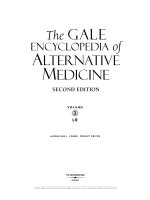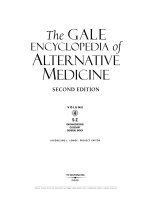- Trang chủ >>
- Y - Dược >>
- Ngoại khoa
oxford handook of geriatric medicine 2nd ed
Bạn đang xem bản rút gọn của tài liệu. Xem và tải ngay bản đầy đủ của tài liệu tại đây (3.24 MB, 724 trang )
OXFORD MEDICAL PUBLICATIONS
Oxford Handbook of
Geriatric Medicine
Oxford Handbook for the Foundation Programme 3e
Oxford Handbook of Acute Medicine 3e
Oxford Handbook of Anaesthesia 3e
Oxford Handbook of Applied Dental Sciences
Oxford Handbook of Cardiology 2e
Oxford Handbook of Clinical and Laboratory Investigation 3e
Oxford Handbook of Clinical Dentistry 5e
Oxford Handbook of Clinical Diagnosis 2e
Oxford Handbook of Clinical Examination and Practical Skills
Oxford Handbook of Clinical Haematology 3e
Oxford Handbook of Clinical Immunology and Allergy 2e
Oxford Handbook of Clinical Medicine - Mini Edition 8e
Oxford Handbook of Clinical Medicine 8e
Oxford Handbook of Clinical Pathology
Oxford Handbook of Clinical Pharmacy 2e
Oxford Handbook of Clinical Rehabilitation 2e
Oxford Handbook of Clinical Specialties 8e
Oxford Handbook of Clinical Surgery 3e
Oxford Handbook of Complementary Medicine
Oxford Handbook of Critical Care 3e
Oxford Handbook of Dental Patient Care 2e
Oxford Handbook of Dialysis 3e
Oxford Handbook of Emergency Medicine 4e
Oxford Handbook of Endocrinology and Diabetes 2e
Oxford Handbook of ENT and Head and Neck Surgery
Oxford Handbook of Epidemiology for Clinicians
Oxford Handbook of Expedition and Wilderness Medicine
Oxford Handbook of Gastroenterology & Hepatology 2e
Oxford Handbook of General Practice 3e
Oxford Handbook of Genitourinary Medicine, HIV and AIDS 2e
Oxford Handbook of Geriatric Medicine 2e
Oxford Handbook of Infectious Diseases and Microbiology
Oxford Handbook of Key Clinical Evidence
Oxford Handbook of Medical Dermatology
Oxford Handbook of Medical Imaging
Oxford Handbook of Medical Sciences
Oxford Handbook of Neonatology
Oxford Handbook of Nephrology and Hypertension
Oxford Handbook of Neurology
Oxford Handbook of Nutrition and Dietetics 2e
Oxford Handbook of Obstetrics and Gynaecology 2e
Oxford Handbook of Occupational Health
Oxford Handbook of Oncology 3e
Oxford Handbook of Ophthalmology 2e
Oxford Handbook of Oral and Maxillofacial Surgery
Oxford Handbook of Paediatrics
Oxford Handbook of Pain Management
Oxford Handbook of Palliative Care 2e
Oxford Handbook of Practical Drug Therapy 2e
Oxford Handbook of Pre-Hospital Care
Oxford Handbook of Psychiatry 2e
Oxford Handbook of Public Health Practice 2e
Oxford Handbook of Reproductive Medicine & Family Planning
Oxford Handbook of Respiratory Medicine 2e
Oxford Handbook of Rheumatology 3e
Oxford Handbook of Sport and Exercise Medicine
Oxford Handbook of Tropical Medicine 3e
Oxford Handbook of Urology 2e
Published and forthcoming Oxford Handbooks
Oxford Handbook of
Geriatric
Medicine
Second edition
Lesley K. Bowker
Consultant in Medicine for the Elderly
Norfolk and Norwich University Foundation Hospital
and
Clinical Skills Director and Honorary Senior Lecturer
Norwich Medical School
University of East Anglia, UK
James D. Price
Consultant in Acute General and Geriatric Medicine
Oxford University Hospitals, UK
Sarah C. Smith
Consultant in Acute General and Geriatric Medicine
Oxford University Hospitals, UK
1
1
Great Clarendon Street, Oxford OX2 6DP,
United Kingdom
Oxford University Press is a department of the University of Oxford.
It furthers the University’s objective of excellence in research, scholarship,
and education by publishing worldwide. Oxford is a registered trade mark of
Oxford University Press in the UK and in certain other countries
© Oxford University Press 2012
The moral rights of the authors have been asserted
First Edition published in 2006
Second Edition published in 2012
Impression: 1
All rights reserved. No part of this publication may be reproduced, stored in
a retrieval system, or transmitted, in any form or by any means, without the
prior permission in writing of Oxford University Press, or as expressly permitted
by law, by licence or under terms agreed with the appropriate reprographics
rights organization. Enquiries concerning reproduction outside the scope of the
above should be sent to the Rights Department, Oxford University Press, at the
address above
You must not circulate this work in any other form
and you must impose this same condition on any acquirer
British Library Cataloguing in Publication Data
Data available
Library of Congress Cataloging in Publication Data
Data available
ISBN 978–0–19–958609–7
Printed in China by
CC Offset Printing Co. Ltd
Oxford University Press makes no representation, express or implied, that the
drug dosages in this book are correct. Readers must therefore always check
the product information and clinical procedures with the most up-to-date
published product information and data sheets provided by the manufacturers
and the most recent codes of conduct and safety regulations. The authors and
the publishers do not accept responsibility or legal liability for any errors in the
text or for the misuse or misapplication of material in this work. Except where
otherwise stated, drug dosages and recommendations are for the non-pregnant
adult who is not breastfeeding.
Links to third party websites are provided by Oxford in good faith and
for information only. Oxford disclaims any responsibility for the materials
contained in any third party website referenced in this work.
v
Geriatrics is medicine of the gaps—such gaps as we see between surgery and
social work, and between psychiatry and orthopaedics. It is the medicine of
the gaps between what doctors need to know for their everyday work and
what they are taught as medical students. Medical curricula are still struc-
tured around diseases and technologies rather than people with diseases
and people needing technologies. The majority of such people are old.
Even more importantly geriatrics has to transcend gaps in ‘evidence-based
medicine’. This is only partly because older people, and especially frail older
people, are left out of clinical trials; there is also a philosophical gap. We start
life with different levels of health and function and we age at different rates.
Older people come to differ from each other more than do younger people;
logic requires that they are treated as individuals not as members of the
homogeneous groups assumed in the rationale of conventional trial evidence.
Some generalizations are possible. It follows from the biology of ageing
that the risk of complications, often preventable or curable, from physically
challenging treatments will increase with age. But it follows, too, that the
benefi ts of treatments that are not physically challenging will also increase
with age. The n-of-1 trial is the relevant but sadly under-used paradigm, its
logic (though not its rigour) underlying the better-known ‘Let’s try it but
stop if it does not work’ trial. With the patient as an active and informed
partner even this is better than the unthinking application of the results of
a clinical trial of dubious relevance.
Because of the evidence gap, geriatric medicine has to be an art as well as a
science—as the authors of this handbook emphasize in their preface. The art
of medicine depends, in William Osler’s words on ‘a sustaining love for ideals’
and, at a practical level, on ability to recognize similarities and to distinguish
signifi cant differences. Good doctors can draw on structured experience and
recognize patterns and warning signals that are unrecorded in the cookbook
medicine of trialists and managers. The cookbooks are based on what
happens on average and our patients expect us to do better than that.
For some of us its interplay of medicine, biology, and social sciences
makes geriatrics a fascinating central interest. But most doctors who
meet with ill older people have other responsibilities as well. They will
enjoy their work better and be more effi cient if they feel able to respond
confi dently to the commoner problems of their older patients. Not every
older person needs a geriatrician any more than every person with heart
failure needs a cardiologist. But all doctors need to know what geriatricians
and cardiologists have to offer and all doctors must be able to recognize
when they are getting out of their depth.
So here is a vade mecum written for the caring and conscientious clinician
but it is not a cookbook. It outlines how to set about analysing complex
clinical situations, and the resources that can or should be called on. The
authors are worthy guides; they have gained and given of their experience
and wisdom in one of the best and busiest of British hospitals. Their aim
is not to supplant but to facilitate thought and good judgement—two
qualities that our older patients need, deserve, and expect of us.
John Grimley Evans
Foreword
vi
This pocket-sized text will function as a friendly, experienced, and knowl-
edgeable geriatrician who is available for advice at all times.
This is a handbook, not a textbook. It is not exhaustive—we have
focused on common problems, including practical help with common
dilemmas which are not well covered by traditional tomes while excluding
the rare and unimportant.
In this second edition, in response to feedback we have increased the
number of ‘HOW TO’ boxes and updated sections where there have
been advances in evidence and practice.
We believe that the practice of geriatric medicine is an art-form and aim
to provide guidance to complement the lists and protocols found in many
textbooks. The evidence-based literature in geriatric medicine is limited,
so advice is often opinion and experience based.
The satisfaction of good geriatric care is lost to many who become
overwhelmed by the breadth and complexity of seemingly insoluble
problems. We provide a structured, logical, and fl exible approach to
problem solving which we hope will give practical help to improve the
care given to older patients in many settings.
Lesley K Bowker
James D Price
Sarah C Smith
Preface
Dedication
We dedicate this book to our children
Nina, Jess, Helen, Cassie, Anna, James, Sam, and Harry
viii
We were delighted when the fi rst edition of this handbook was used as
the basis of the American Oxford Handbook of Geriatric Medicine (2010)
and have consulted it extensively during the production of this second
edition—we extend our thanks to Professor Samuel Durso and colleagues.
Acknowledgements
Symbols and abbreviations xi
1 Ageing
1
2 Organizing geriatric services
13
3 Clinical assessment of older people
51
4 Rehabilitation
71
5 Falls and funny turns
101
6 Drugs
125
7 Neurology
151
8 Stroke
179
9 Psychiatry
203
10 Cardiovascular
255
11 Chest medicine
311
12 Gastroenterology
351
13 Renal medicine
383
14 Homeostasis
403
15 Endocrinology
419
16 Haematology
451
17 Musculoskeletal system
465
18 Pressure injuries
501
19 Genitourinary medicine
507
20 Incontinence
531
21 Ears
547
22 Eyes
567
23 Skin
585
24 Infection and immunity
605
25 Malignancy
627
Contents
ix
x
CONTENTS
26 Death and dying
637
27 Ethics
653
28 Finances
677
Appendix: Further Information
685
Index 697
xi
M website cross-reference
b cross-reference to other sections of the book or to
external material
2 Caution!
AAMI age-associated memory impairment
ABG arterial blood gas
ABPI ankle–brachial pressure index
ACE angiotensin-converting enzyme
ACTH adrenocorticotropic hormone
AD advance directive
ADH antidiuretic hormone
ADLs activities of daily living
AF atrial fi brillation
AKI acute kidney injury
ALP alkaline phosphatase
AMD age-related macular degeneration
AMTS abbreviated mental test score
ANA antinuclear antibody
ANCA antineutrophilic cytoplasmic antibody
ARB angiotensin receptor blocker
ARDS adult respiratory distress syndrome
ATN acute tubular necrosis
AV atrioventricular
AXR abdominal X-ray
BCG bacille Calmette Guérin
bd twice daily
BMI body mass index
BNF British National Formulary
BNP B-type natriuretic peptide
BPH benign prostatic hyperplasia
BPPV benign paroxysmal positional vertigo
CABG coronary artery bypass grafting
CDAD Clostridium diffi cile-
associated diarrhoea
CDT clock-drawing test
CGA comprehensive geriatric assessment
CH community hospital
Symbols and abbreviations
xii
SYMBOLS AND ABBREVIATIONS
CHD coronary heart disease
CJD Creutzfeldt–Jakob disease
CK creatine kinase
CKD chronic kidney disease
CNS central nervous system
COPD chronic obstructive pulmonary disease
COX-2 cyclo-oxygenase-2
CPR cardiopulmonary resuscitation
CRP C-reactive protein
CSF cerebrospinal fl uid
CSS carotid sinus syndrome
CT computed tomography
CXR chest radiograph
DH day hospital
DIC disseminated intravascular coagulation
DNACPR do not attempt cardiopulmonary resuscitation
DoLS Deprivation of Liberty Safeguards
DRE digital rectal examination
DVs domiciliary visits
DVT deep vein thrombosis
ECG electrocardiogram
ED emergency department
EEG electroencephalogram
eGFR estimated glomerular fi ltration rate
EMG electromyography
EMI elderly mentally infi rm
ERCP endoscopic retrograde cholangiopancreatography
ESR erythrocyte sedimentation rate
FEV
1
forced expiratory volume in 1sec
FNA fi ne needle aspiration
GCA giant cell arteritis
GCS Glasgow Coma Scale
GDS Geriatric Depression Scale
GFR glomerular fi ltration rate
GORD gastro-oesophageal refl ux disease
GP general practitioner
GTN glyceryl trinitrate
HbA
1c
glycosylated haemoglobin
HDU high dependence unit
HIV human immunodefi ciency virus
xiii
SYMBOLS AND ABBREVIATIONS
HRT hormone replacement therapy
HUTT head-up tilt table testing
IHD ischaemic heart disease
im intramuscular
IMCA independent mental capacity advocate
INR international normalized ratio
ITU intensive therapy/care unit
iv intravenous
IVC inferior vena cava
JVP jugular venous pressure
LBBB left bundle branch block
LDH lactate dehydrogenase
LFT liver function test
LHRH luteinizing hormone releasing hormone
LKM liver-kidney microsome (antibodies)
LMN lower motor neuron
LPA lasting power of attorney
LTOT long-term oxygen therapy
LUTS lower urinary tract symptoms
LVH left ventricular hypertrophy
MCA middle cerebral artery
MCV mean corpuscular volume
MDT multidisciplinary team
MEAMS Middlesex Elderly Assessment of Mental State
MI myocardial infarction
MM multiple myeloma
MMSE Mini-Mental State Examination
MND motor neuron disease
MOAI monoamine oxidase inhibitor
MRI magnetic resonance imaging
MRSA meticillin-resistant Staphylococcus aureus
MSU midstream urine
N+V nausea and vomiting
NG nasogastric
NGT nasogastric tube
NICE National Institute for Health and Clinical Excellence
NIHSS National Institutes for Health Stroke Scale
NPH normal pressure hydrocephalus
NSAID non-steroidal anti-infl ammatory drug
NSF national service framework
xiv
SYMBOLS AND ABBREVIATIONS
NSTEMI non-ST elevation myocardial infarction
OA osteoarthritis
OAB overactive bladder
od once daily
OGD oesophagogastroduodenoscopy
OT occupational therapy (or therapist)
PCI percutaneous coronary intervention
PCT primary care trust
PE pulmonary embolism
PEFR peak expiratory fl ow rate
PEG percutaneous endoscopic gastrostomy
PMR polymyalgia rheumatica
po orally
POA power of attorney
PPD purifi ed protein derivative
pr per rectum (anally)
PRN as-needed
PSA prostrate-specifi c antigen
PT physiotherapy (or therapist)
PTH parathyroid hormone
qds four times daily
RBBB right bundle branch block
RCT randomized controlled study
REM rapid eye movement
RIG radiologically inserted gastrostomy
SA sinoatrial
SALT speech and language therapy (or therapist)
SAP single assessment process
s/c subcutaneous
SIADH syndrome of inappropriate ADH secretion
SLE systemic lupus erythematosus
SMA smooth muscle antibody
SNRI serotonin and noradrenaline reuptake inhibitor
SPECT single photon emission computed tomography
SpR specialist registrar
SSRI selective serotonin reuptake inhibitor
STD sexually transmitted disease
STEMI ST elevation myocardial infarction
SVT supraventricular tachycardia
T3 triiodothyronine
xv
SYMBOLS AND ABBREVIATIONS
T4 levothyroxine
TB tuberculosis
tds three times daily
TENS transcutaneous nerve stimulation
TFT thyroid function test
TIA transient ischaemic attack
TIBC total iron binding capacity
tPA tissue plasminogen activator
TSH thyroid stimulating hormone
TTO to take out (discharge drugs)
TURP transurethral resection of the prostate
U,C+E urea, creatinine and electrolytes
UMN upper motor neuron
UTI urinary tract infection
UV ultraviolet
VATS video-assisted thoracoscopy with biopsy
VBI vertebrobasilar insuffi ciency
VT ventricular tachycardia
VTE venous thromboembolism
V/Q ventilation-perfusion
WBC white blood cell
WHO World Health Organization
This page intentionally left blank
1
The ageing person 2
Theories of ageing 3
Demographics: life expectancy 4
Demographics: population age structure 6
Demographics: ageing and illness 8
Illness in older people 10
Ageing
Chapter 1
2 CHAPTER 1 Ageing
The ageing person
There are many differences between old and young people. In only some
cases are these changes due to true ageing, ie due to changes in the
characteristic(s) compared with when the person was young.
Changes not due to ageing
• Selective survival. Genetic, psychological, lifestyle, and environmental
factors infl uence survival, and certain characteristics will therefore be
over-represented in older people
• Differential challenge . Systems and services (health, fi nance, transport,
retail) are often designed and managed in ways that make them more
accessible to young people. The greater challenge presented to older
people has manifold effects (eg impaired access to health services)
• Cohort effects . Societies change, and during the twentieth century,
change has been rapid in most cases. Young and old have therefore been
exposed to very different physical, social, and cultural environments
Changes due to ageing
• Primary ageing . Usually due to interactions between genetic (intrinsic,
‘nature’) and environmental (extrinsic, ‘nurture’) factors. Examples
include lung cancer in susceptible individuals who smoke, hypertension
in susceptible individuals with high salt intake, and diabetes in those
with a ‘thrifty genotype’ who adopt a more profl igate lifestyle
• Additionally there are genes which infl uence more general,
cellular ageing processes. Only now are specifi c genetic disease
susceptibilities being identifi ed, offering the potential to intervene
early and to modify risk
• Secondary ageing . Adaptation to changes of primary ageing. These are
commonly behavioural, eg reduction or cessation of driving as reaction
times increase
Ageing and senescence
Differences between old and young people are thus heterogeneous, and
individual effects may be viewed as:
• Benefi cial (eg increased experiential learning, increased peak bone
mineral density (refl ecting the active youth of older people))
• Neutral (eg greying of hair, pastime preferences)
• Disadvantageous (eg decreased reaction time, development of
hypertension)
However, the bulk of changes, especially in late middle and older age, are
detrimental, especially in meeting pathological and environmental chal-
lenges. This loss of adaptability results from homeostatic mechanisms that
are less prompt, less precise, and less potent than they once were. The
result is death rates that increase exponentially with age, from a nadir
around age 12. In very old age (80–100 years), some tailing off of the
rate of increase is seen, perhaps due to selective survival, but the increase
continues nonetheless.
Further reading
Evans JG , Williams TF , Beattie BL , et al. (eds) ( 2003 ). Oxford Textbook of Geriatric Medicine , 2nd
edition, Section 2. Oxford : Oxford University Press .
3
THEORIES OF AGEING
Theories of ageing
With few exceptions, all animals age, manifesting as increased mortality
and a fi nite lifespan. Theories of ageing abound, and over 300 diverse the-
ories exist. Few stand up to careful scrutiny, and none has been confi rmed
as defi nitely playing a major role. Four examples follow.
Oxidative damage
Reactive oxygen species fail to be mopped up by antioxidative defences
and damage key molecules, including DNA. Damage builds up until key
metabolic processes are impaired and cells die.
Despite evidence from in vitro and epidemiological studies supporting
benefi cial effects of antioxidants (eg vitamins C and E), clinical trial results
have been disappointing.
Abnormal control of cell mitosis
For most cell lines, the number of times that cell division can occur is
limited (the ‘Hayfl ick limit’). Senescent cells may predominate in tissues
without signifi cant replicative potential such as cornea and skin. The
number of past divisions may be ‘memorized’ by a functional ‘clock’ —
DNA repeat sequences (telomeres) shorten until further division ceases.
In other cells, division may continue uncontrolled, resulting in hyperplasia
and pathologies as diverse as atherosclerosis and prostatic hyperplasia.
Protein modifi cation
Changes include oxidation, phosphorylation, and glycation (non-enzymatic
addition of sugars). Complex glycosylated molecules are the fi nal result
of multiple sugar–protein interactions, resulting in a structurally and func-
tionally abnormal protein molecule.
Wear and tear
There is no doubt that physical damage plays a part in ageing of some
structures, especially skin, bone, and teeth, but this is far from a universal
explanation of ageing.
Ageing and evolution
In many cases, theories are consistent with the view that ageing is a by-
product of genetic selection: favoured genes are those that enhance
reproductive fi tness in earlier life but which may have later detrimental
effects. For example, a gene that enhances oxidative phosphorylation may
increase a mammal’s speed or stamina, while increasing the cumulative
burden of oxidative damage that usually manifests much later.
Many genes appear to infl uence ageing; in concert with differential
environmental exposures, these result in extreme phenotypic heterogeneity,
ie people age at different rates and in different ways.
4 CHAPTER 1 Ageing
Demographics: life expectancy
• Life expectancy (average age at death) in the developed world has
been rising since accurate records began and continues to rise linearly
• Lifespan (maximum possible attainable age) is thought to be around
120 years. It is determined by human biology and has not changed
• Population ageing is not just a minor statistical observation but a
dramatic change that is easily observed in only a few generations
• In 2002, life expectancy at birth for women born in the UK was
81 years, and 76 years for men
• This contrasts with 49 and 45 years, respectively, at the end of the
nineteenth century
• Although worldwide rises in life expectancy at birth are mainly
explained by reductions in perinatal mortality, there is also a clear
prolongation of later life in the UK as shown by calculations of life
expectancy at 50 or 65 (see Fig. 1.1 )
• Between 1981 and 2002, life expectancy at age 50 increased by
4.5 years for men and 3 years for women
• While projections suggest this trend will continue, it is possible that
the modern epidemic of obesity might slow or reverse this
Individualized life expectancy estimates
Simple analysis of population statistics reveals that mean male life expect-
ancy is 76 years. However, this is not helpful when counselling an 80 year
old. Table 1.1 demonstrates that as a person gets older their individual life
expectancy actually increases. This has relevance in deciding on healthcare
interventions.
More accurate individualized estimates should take into account sex,
previous and current health, longevity of direct relatives, as well as social
and ethnic group.
Table 1.1 Predicted life expectancy at various ages for men, UK
Age at time of estimate Median years left to live That is, death at age
40 36.5 76.5
60 17.9 77.9
80 5.6 85.6
90 2.8 92.8
5
DEMOGRAPHICS: LIFE EXPECTANCY
Fig. 1.1 Expected further years of life at age 50 and 65, UK.
Reproduced with permission from M www.statistics.gov.uk .
6 CHAPTER 1 Ageing
Demographics: population age
structure
Fertility
Fertility is defi ned as the number of live births per adult female. It is cur-
rently around 1.9 in the UK. If this rate were maintained, then in the long
term population would fall unless ‘topped up’ by net immigration. In con-
trast during the ‘baby boom’ years of the 1950s, fertility rates reached
almost 3. This bulge in the population pyramid will reach old age in 2010–
2030, increasing the burden on health and social services.
Deaths and cause of death
The driver of mortality decline has changed over the twentieth century,
from reductions in infant/child mortality to reductions in old age mortality.
• Infant mortality accounted for 25 % of deaths in 1901, but had fallen to
4 % of deaths by 1950. Currently over 96 % of deaths occur > 45 years
• Deaths at age 75 and over comprised 12 % of all deaths in 1901, 39 % in
1951, and 65 % in 2001
The most common cause of death in people aged 50–64 is cancer (lung
in men, breast cancer in women); 39 % of male and 53 % of female deaths
are due to cancer. Over the age of 65, circulatory diseases (heart attacks
and stroke) are the most common cause of death. Pneumonia as a cause
of death also increases with age to account for 1 in 10 among those aged
85 and over.
All these statistics rely on the accuracy of death certifi cation (see b
‘Documentation after death’, p.648) which is likely to reduce with
increasing age.
Population ‘pyramids’
These demonstrate the age/sex structure of different populations. The
shape is determined by fertility and death rates. ‘Pyramids’ from devel-
oping nations (and the UK in the past) have a wide base (high fertility
but also high death rates, especially in childhood) and triangular tops
(very small numbers of older people). In the developed world the shape
has become more squared off (see Fig. 1.2 ) with some countries having
an inverted pyramidal shape — people in their middle years outnumber
younger people — as fertility declines below replacement values for
prolonged periods.
7
DEMOGRAPHICS: POPULATION AGE STRUCTURE
Fig. 1.2 Population pyramid for England and Wales 2004.
Reproduced with permission from M www.statistics.gov.uk .
8 CHAPTER 1 Ageing
Demographics: ageing and illness
Healthy life expectancy and prevalence of morbidity
Healthy life expectancy is that expected to be spent in good or fairly good
health. As total life expectancy rises it is better for society and the indi-
vidual to spend as much of this extended life in good health as possible.
It is not known whether ‘compression of morbidity’ — where illness
and disability is squeezed into shorter periods at the end of life — can
be achieved. Trends in data from USA suggest that compression of
morbidity is occurring, but challenges to public health are different in the
UK. Obesity and lack of exercise may negate diminishing morbidity from
infectious diseases; as more people survive vascular deaths they might
develop dementia (and other old age-associated diseases). The jury is still
out; some data gathered in the UK using self-rated health measures show
that in 1981 the expected time lived in poor health was 6.5 years (men)
and 10.1 years (women); by 2001 this was 8.6 and 10.7 years.
Social impact of ageing population
Those > 80 are the fastest growing age group in UK. Currently around
a quarter of the population is > 60 years old but by 2030 this will rise to
a third. Governments can encourage migration (economic migrants are
mostly young) and extend working lives (eg increase pensionable age for
women) but these will have little effect on the overall shift. The impact
of this demographic shift on society’s attitudes and economies is huge.
Examples include:
• Financing pensions and health services — in most countries these are
fi nanced on a ‘pay-as-you-go’ system, so will have to be paid for by a
smaller workforce. This will inevitably mean greater levels of taxation
for those in work or a reduction in the state pension. Unless private
pension investment (which works on an ‘insurance’ system of personal
savings) improves there is a risk that many pensioners will continue to
live in relative poverty
• Healthcare and disability services — the prevalence and degree of
disability increases with age. American Medicare calculations show that
more than a quarter of healthcare expenditure is on the last year of a
person’s life, with half of that during the last 60 days
• Families are more likely to be supporting older members
• Retired people comprise a growing market and companies/industries
that accommodate the needs/wishes of older people will fl ourish
• Transport, housing, and infrastructure must be built or adapted
• Political power of older people (the ‘grey lobby’ in America) will grow









